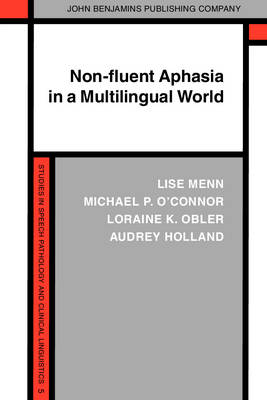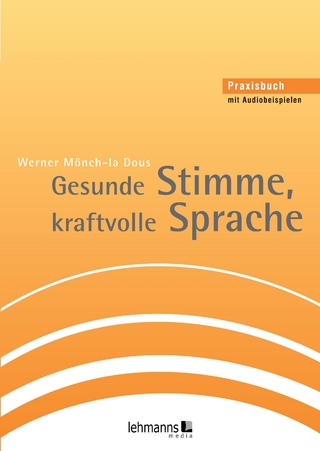
Non-fluent Aphasia in a Multilingual World
John Benjamins Publishing Co (Verlag)
978-90-272-4336-2 (ISBN)
“Non-fluent Aphasia in a Multilingual World” is an up-to-date introduction to the language of patients with non-fluent aphasia. Recent research in languages other than English has challenged our old descriptions of aphasia syndromes: while their patterns can be recognized across languages, the structure of each language has a profound effect on the symptoms of aphasic speech. However, the basic linguistic concepts needed to understand these effects in languages other than English have rarely been part of the training of the clinician.
“Non-fluent Aphasia in a Multilingual World” introduces these concepts plainly and concretely, in the context of dozens of examples from the narratives and conversations of patients speaking most of the major languages of Europe, North America and Asia. Linguistic and clinical terms are carefully defined and kept as theory neutral as possible.
“Non-Fluent Aphasia in a Multilingual World” is especially useful for speech-language pathologists whose patients are immigrants and guestworkers, and for the clinician who must deal creatively with the challenges of providing aphasia diagnosis and therapy in a multicultural, multidialectical setting.
1. List of Figures; 2. List of Excerpts; 3. Abbreviations and Conventions; 4. Acknowledgments; 5. Foreword by Michel Paradis; 6. 1. Introduction; 7. 1.1. The purpose of this book: Audience and goals; 8. 1.2. The types of patients that the book is based on; 9. 1.3. Additional sources of information; 10. 1.4. The plan of the book; 11. 1.5. Linguistics and aphasia; 12. 2. Describing and Comparing Languages; 13. 2.1. Introduction: Why we need linguistic terminology; 14. 2.2. Grammar across the world's languages: The basic types of information conveyed by syntax and morphology; 15. 2.3. Typology and terminology: Common types of morphemes and syntactic structures; 16. 2.4. Pragmatics: Describing sentence types and their uses in conversation; 17. 2.5. Reasoning from linguistic typology: Extrapolating from available data to aphasia in languages not yet studied; 18. 2.6. How to read and use an interlinear morphemic transcription; 19. Recommended readings; 20. Exercises; 21. 3. Basic Properties of Agrammatic Narratives; 22. 3.1. Introduction; 23. 3.2. How do we know what is normal?: The need for control subjects; 24. 3.3. Getting patients to talk: Narrative elicitation; 25. 3.4. General properties of agrammatic narratives; 26. 3.5. Comparing elicitation materials; 27. 3.6. Potential intercultural problems; 28. 3.7. Chapter summary; 29. 4. The Grammar of Connected Agrammatic Speech; 30. 4.1. Introduction; 31. 4.2. Major grammatical phenomena; 32. 4.3. Consequences and contrasts: Counterevidence to some popular descriptions and theories; 33. 5. Speech, Writing, and Oral Reading; 34. 5.1. Introduction: Why should there be either differences or similarities across different types of language output?; 35. 5.2. Disturbances in spontaneous writing; 36. 5.3. Disturbances in reading aloud; 37. 5.4. Differences in degree of disturbance of writing and speech; 38. Exercise; 39. 6. Bilingual and Polyglot Aphasia (by Obler, Loraine K.); 40. 6.1. Introduction; 41. 6.2. Parallel and differential deficits; 42. 6.3. Causes for differential recovery; 43. 6.4. Special bilingual behaviors; 44. 6.5. Brain organization for bilingualism; 45. 6.6. Implications for diagnosis; 46. 7. Inventing Therapy for Aphasia (by Holland, Audrey); 47. 7.1. Introduction: Cross-cultural and cross-linguistic issues; 48. 7.2. Treatment for agrammatism; 49. 7.3. Some concluding comments; 50. Appendices; 51. A. Foreign Accents (Non-native Phonetics) and Dysarthria; 52. B. Language Families; 53. C. Clinical Resources; 54. Clinical Glossary; 55. Linguistic Glossary; 56. References
| Erscheint lt. Verlag | 30.11.1995 |
|---|---|
| Reihe/Serie | Studies in Speech Pathology and Clinical Linguistics ; 5 |
| Verlagsort | Amsterdam |
| Sprache | englisch |
| Maße | 160 x 240 mm |
| Gewicht | 300 g |
| Themenwelt | Geisteswissenschaften ► Sprach- / Literaturwissenschaft ► Sprachwissenschaft |
| Medizin / Pharmazie ► Gesundheitsfachberufe ► Logopädie | |
| ISBN-10 | 90-272-4336-0 / 9027243360 |
| ISBN-13 | 978-90-272-4336-2 / 9789027243362 |
| Zustand | Neuware |
| Haben Sie eine Frage zum Produkt? |
aus dem Bereich


